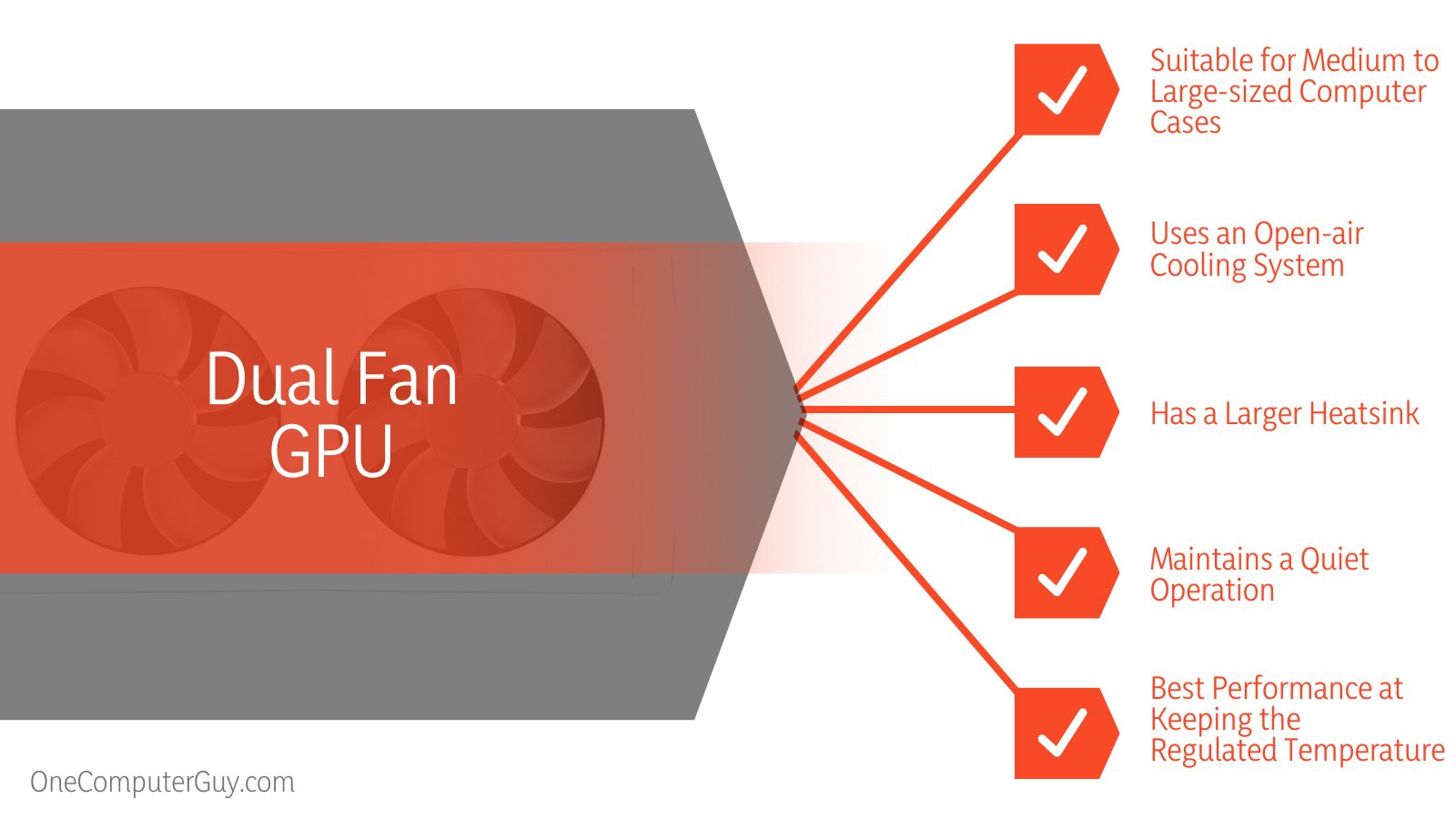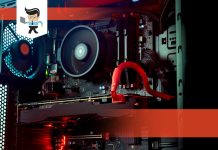Choosing between a single fan vs. dual fan GPU is just as essential as choosing the ideal CPU for your custom gaming rig. While both types of GPU are designed to provide excellent performance and efficiency, they differ greatly in terms of cooling performance, functionality, pricing, and noise levels.
 To help you make the right choice when building your rig, we’ll be sharing insights from our computer experts.
To help you make the right choice when building your rig, we’ll be sharing insights from our computer experts.
Contents
Single Fan GPU vs. Dual Fan GPU: Knowing the Difference
The main difference between Single Fan and Dual Fan GPU is, Single fan GPU has a small form factor and uses a blower-style method for their cooling, while are more efficient at heat dissipation but don’t blow heat out of the PC case.
Both single fan graphic card and dual fan graphic card have their own pros and cons. Let’s take a look at the differences and similarities between both. This comparison will help you understand the ideal GPU for your rig, thereby enhancing your buying decision.
| Single Fan GPU | Dual Fan GPU | |
| Size | Small; works with most small PC cases and ITX cases | Has a larger footprint; suitable for medium to large-sized computer cases |
| Functionality | Utilizes a blower-style cooling system | Uses an open-air cooling system |
| Performance | Has smaller heatsink and a single fan; it tends to slow down in performance | Has a larger heat sink and dual fans; it maintains cooling efficiency |
| Noise Levels | Tends to be noisy | Maintains a quiet operation |
| Overclocking | Loses efficiency for high overclocks | Gets the best performance at keeping the regulated temperature |
– GPU Sizes
When choosing a graphics card for your rig, one of the most important factors to consider is its size. The size of your GPU should fit with the room you have in your PC chassis.
Additionally, the GPU you choose, whether dual fan or single fan will be powered by your PSU. Therefore you need to make sure your power unit is able to provide the required wattage to power your graphics card.
As you would expect, both the single fan graphic card and dual fan graphic card are different in size.
While the single fan is often small and can work with most small PC cases and ITX cases, the dual fan GPU tends to have a larger footprint and is usually suitable for medium to large-sized computer cases.
The small size of a mini graphics card also allows it to take less space on your motherboard, thereby allowing you to add more components without space issues. On the other hand, a dual-fan GPU takes up a lot of motherboard space so you need to make sure that you have a lot of clearance.
Single fan GPUs are quite compatible with many different builds because they work with most standard dimensions. So if you’re building a PC with a small case, a single fan GPU may be all you need.
– GPU Functionality
Both single and dual fan GPUs are designed with excellent cooling systems, including a heatsink and a fan. These cooling components help remove excess heat while maintaining the best temperature levels for the graphics card.
 However, both dual fan and single fan graphics cards have different cooling methods. The way their cooling fans work is quite different from each other.
However, both dual fan and single fan graphics cards have different cooling methods. The way their cooling fans work is quite different from each other.
Single fan graphics cards utilize a blower-style cooling system to remove hot air from the GPU out of the case. On the other hand, dual-fan GPUs make use of an open-air cooling system thanks to their open design. This system involves spreading the air from the fan over the heatsink and then releasing it back into the computer’s casing through the graphics card’s bottom and from vents.
– Overclocking
When it comes to boosting the performance of your PC, overclocking is undoubtedly one of the best ways to do so, especially if your GPU isn’t overclocked out of the box. But like almost everything else in life, overclocking your GPU has its own cons, with the most common being heat.
An overclocked GPU tends to need a powerful cooling system to help regulate its temperature so you can get the best performance. Too much heat can significantly reduce the life span of your GPU.
Therefore, choosing a GPU with a powerful cooling system will help you prevent throttling as it will allow you to optimize the speed of your fan, thereby making sure your GPU achieves maximum cooling capacity.
Single fan GPUs are often designed with fans that are capable of keeping the temperatures down when they’re operating at normal speeds. However, their fans tend to lose their efficiency for high overclocks.
-
What to Do When it Comes to Overclocking
Choosing a GPU with multiple fans is often the best option to work with if you’re thinking about overclocking. Multiple fan graphics cards, such as dual fan GPUs provide enough airflow to keep the temperature level of overclocks in check, which in turn eliminates throttling.
Also, you should make sure your PC case has enough airflow because a dual fan GPU won’t remove the heat from your chassis. Both dual and single fan GPUs are built with PWM support. This feature allows them to automatically adjust the speed of their fans to get the best performance.
You can also increase the max fan speeds manually if the GPU’s temperature goes beyond the normal range and reduces the speed when the temperature drops significantly.
– Performance
When it comes to cooling performance, dual-fan GPUs have an edge over single fan GPUs as they dissipate heat faster and more efficiently thanks to their dual fans.
Additionally, dual-fan GPUs have a larger heat sink that’s designed with copper heat pipes. This design increases their cooling efficiency significantly.
On the other hand, single fan GPUs have a smaller heatsink and a single fan. This design makes their cooling capacity a lot smaller than what you get on dual-fan GPUs.
That said, you may not notice a significant difference between both GPU types if they are used for a short period of time. The only time you’re likely to notice the difference in cooling capacity and heat dissipation is when both graphics cards are used for an extended period of time.
As time goes on, single fan GPUs tend to slow down in performance while dual-fan graphics cards maintain their cooling efficiency. Dual fan GPUs will continue to keep the graphics card’s temperatures within safer levels thanks to the additional fan they are built with.
With this in mind, you can come to the conclusion that dual-fan graphics cards can provide you with a higher frame rate that’s perfect for graphics-intensive tasks or gaming since they offer more efficient cooling.
 – Noise Levels
– Noise Levels
There are many different factors contributing to the varying amounts of noise levels produced by different GPU fans.
For instance, a small GPU fan spinning very fast is often to supplement the smaller heat sink on the GPU. An increase in fan speed will automatically lead to an increase in noise levels, which is why single fan GPUs tend to be noisier than their dual fan counterparts.
On the other hand, dual-fan GPUs are designed with dual axial-style fans that have large roller blades. They rotate at low speeds and provide streamlined and ample airflow needed to keep the heatsink cool. The ability of these two fans to rotate for extended periods while providing improved cooling capacity without spinning at maximum speeds is the reason why they can maintain a quiet operation.
All in all, dual-fan GPUs have a higher chance of maintaining quiet operations than single fan GPUs when under the same load or task. They can run at lower speeds while still producing a lot of air, thereby bringing the noise levels down to a minimum.
– Pre-Built Cooling System
Single fan GPUs are the ideal options for PC builders whose computer’s pre-built cooling system isn’t efficient. A single fan GPU uses a blower-style cooling method to remove hot air from your PC case.
So if your pre-built cooling system doesn’t offer a quality cooling solution, the cooling method of the fan from a single fan GPU will cool your graphics card and also push hot air out of the case. This will allow your card and other PC components to remain safe under a good temperature range.
On the other hand, while dual fans provide excellent and efficient cooling, they are not designed to carry air out of your PC case. So, the best scenario to use a dual fan GPU will be when your pre-built cooling system offers excellent cooling capacity.
This way, when the GPU fan provides ample heat dissipation and cooling to bring the GPU temperatures down, the pre-built cooling system will complement it by taking the hot air out of the PC case. With this combination, your GPU and other VRM components will be safe from overheating.
– Pricing
The price of a GPU is an essential factor to consider when building a rig. You may be thinking the smaller single fan GPU will be a lot cheaper than the dual fan GPU, but in truth, the price difference between both isn’t that significant.

Generally, most single fan GPUs tend to be less expensive than dual-fan GPUs in the same category due to their limited cooling capacity and lack of extra features. Dual fan GPUs are likely to always cost more since they offer better cooling capabilities.
High-end dual fan models are even more expensive because, besides efficient heat dissipation, they often feature extra features, such as RGB LED lighting, thermal pads, advanced customizations, sensors, and more.
However, if you’re on a budget, you can always find a great dual-fan GPU with fewer features. Also, it’s important to note that you’ll have to fork out more cash if you’re looking to get a GPU with overclocking capabilities. The good thing is that most of the GPUs on the market nowadays are designed to provide excellent performance when paired with a good cooler.
Single Fan vs. Dual Fan GPU: Frequently Asked Questions
1. Does Dual Fan GPU Increase FPS?
Thanks to their cooling efficiency, dual-fan GPUs tend to offer better FPS than their single fan counterparts. Single fan GPUs are designed with just one fan, which means that it will take a longer time to bring their temperature back to normal. A high GPU temperature means that you’re bound to experience lag as well as a drop in performance and frame rates.
On the other hand, dual-fan GPUs can quickly bring the temperature under control thanks to the additional fan. However, it’s important to pair your dual fan GPU with a good pre-built cooling system since the fans are unable to push heat out of the PC case. Doing this will help increase the efficiency of the fan while protecting your PC components.
2. Is Single Fan GPU Good For Gaming?
Yes, it is. However, the kind of games you play also matters. If you play graphic-intensive games, you may not get the best experience when your graphic card’s temperature rises. But if you play games with moderate graphics, you’re likely going to have smooth gameplay.
3. Can You Cool a GPU With a CPU Cooler?
No, you can’t. The reason is that your GPU will have no bracket where you can mount the CPU cooler. Graphics card and processor mounts aren’t designed to be interchangeable.
Also, most CPU coolers are not designed to provide the kind of heat dissipation a GPU requires.
Conclusion
We hope that you now understand the major differences between a dual and single fan GPU. Here are some key points to keep in mind when making your buying decision:
- Single fan GPU has a small form factor and is ideal for smaller rigs
- Dual fan GPUs are great for medium to full-sized rigs
- Single fan GPUs use a blower-style method for their cooling
- Single fan graphics cards blow heat out of the PC case
- Dual fan GPUs are more efficient at heat dissipation but don’t blow heat out of the PC case
- Dual fan GPUs are better for overclocking compared to their single fan counterparts
- Single fan GPUs produce more noise than dual-fan GPUs
- Dual fan graphic cards tend to be pricier than single fan GPUs
Both GPU types have their own pros and cons so you should make careful considerations when deciding on the one to buy. Make sure you consider your pre-built cooling capacity, frame rates, overclocking, and other factors, and you’ll be able to make the ideal decision.







